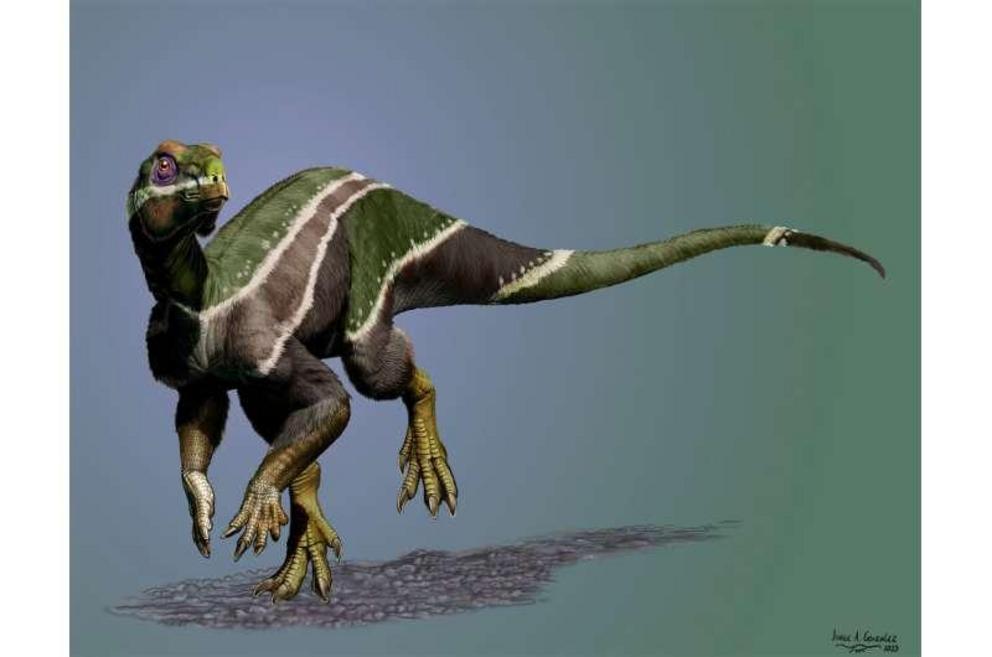Newly discovered dinosaur, 'Iani,' was face of a changing planet
Iani smithi.
A newly discovered plant-eating dinosaur may have been a species' "last gasp" during a period when Earth's warming climate forced massive changes to global dinosaur populations.
The specimen, named Iani smithi after Janus, the two-faced Roman god of change, was an early ornithopod, a group of dinosaurs that ultimately gave rise to the more commonly known duckbill dinosaurs such as Parasaurolophus and Edmontosaurus. Researchers recovered most of the juvenile dinosaur's skeleton—including skull, vertebrae and limbs—from Utah's Cedar Mountain Formation. The research is published in PLoS ONE.
Iani smithi lived in what is now Utah during the mid-Cretaceous, approximately 99 million years ago. The dinosaur's most striking feature is its powerful jaw, with teeth designed for chewing through tough plant material.
The mid-Cretaceous was a time of big changes, which had big effects on dinosaur populations. Increased atmospheric carbon dioxide during this time caused the Earth to warm and sea levels to rise, corralling dinosaurs on smaller and smaller landmasses. It was so warm that rainforests thrived at the poles. Flowering plant life took over coastal areas and supplanted normal food sources for herbivores.
3D reconstruction of the skull of Iani smithi.
In North America, giant plant-eating sauropods—once titans of the landscape—were disappearing, along with their allosaurian predators. At the same time, smaller plant eaters, like early duckbills and horned dinosaurs, and feathered theropods like tyrannosaurs and enormous oviraptorosaurs, were arriving from Asia.
Enter Iani smithi, unique not only because it's newly discovered, but also because of its rarity in the North American fossil record and its position in dinosaur history.
"Finding Iani was a streak of luck. We knew something like it lived in this ecosystem because isolated teeth had been collected here and there, but we weren't expecting to stumble upon such a beautiful skeleton, especially from this time in Earth's history. Having a nearly complete skull was invaluable for piecing the story together," says Lindsay Zanno, associate research professor at North Carolina State University, head of paleontology at the North Carolina Museum of Natural Sciences, and corresponding author of the work.

Location of holotype locality for Iani smithi. (A) Global map showing location of Mussentuchit Member outcrop in central Utah, western North America, and a stratigraphic section at the quarry with dated ash horizons; and (B) graphical representation of preserved skeletal elements of the holotype specimen. Preserved elements are colored on the left facing skeletal whether they derive from the right or left side of the body. Exact positions of chevrons and ribs unknown due to poor preservation.
Zanno and her team used the well-preserved skeleton to analyze the evolutionary relationships of Iani and were surprised—and a bit skeptical—of the results.
"We recovered Iani as an early rhabdodontomorph, a lineage of ornithopods known almost exclusively from Europe," Zanno says. "Recently, paleontologists proposed that another North American dinosaur, Tenontosaurus—which was as common as cattle in the Early Cretaceous—belongs to this group, as well as some Australian critters. If Iani holds up as a rhabdodontomorph, it raises a lot of cool questions."
Key among these is, could Iani be a last gasp, a witness to the end of a once successful lineage? Zanno thinks that studying this fossil in the context of environmental and biodiversity changes during the mid-Cretaceous will give us more insight into the history of our planet.
Iani smithi is named for Janus, the two-faced god who symbolized transitions—an apt name, given its position in history.
"Iani may be the last surviving member of a lineage of dinosaurs that once thrived here in North America but were eventually supplanted by duckbill dinosaurs," Zanno says. "Iani was alive during this transition—so this dinosaur really does symbolize a changing planet.
"This dinosaur stood on the precipice," she says, "able to look back at the way North American ecosystems were in the past, but close enough to see the future coming like a bullet train. I think we can all relate to that."
More information: An early-diverging iguanodontian (Dinosauria: Rhabdodontomorpha) from the Late Cretaceous of North America, PLoS ONE (2023). DOI: 10.1371/journal.pone.0286042
Journal information: PLoS ONE
Provided by North Carolina State University

